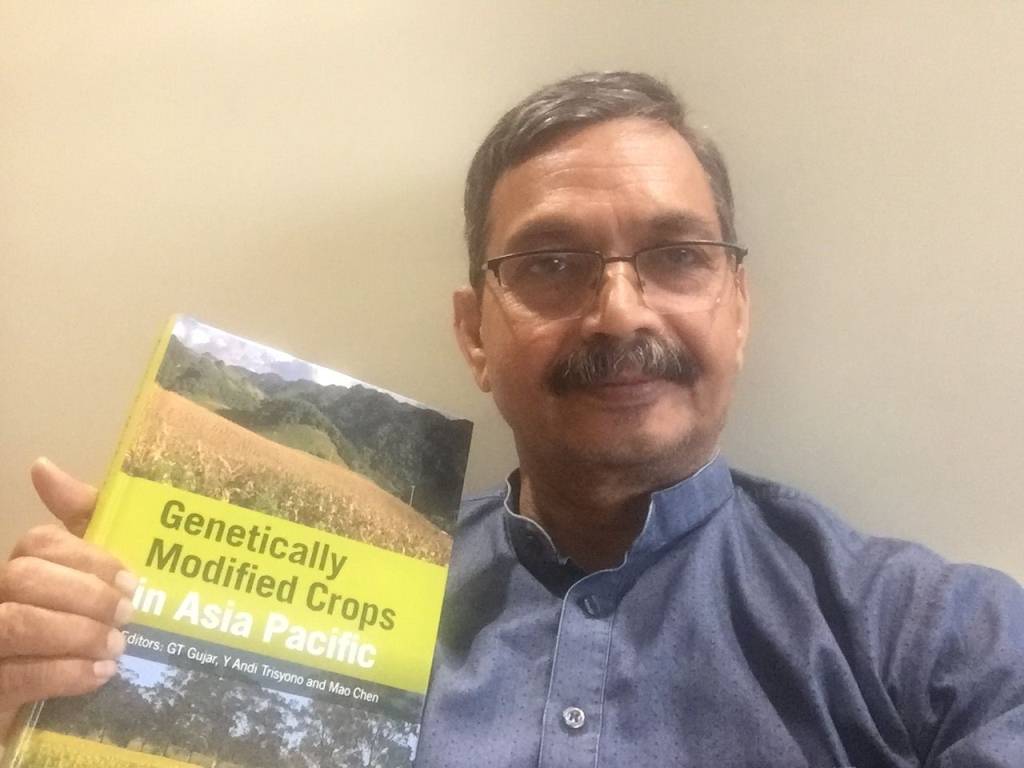
Meeting future food needs without compromising environmental integrity is a central challenge for agriculture globally but especially for the Asia Pacific region – where 60% of the global population, including some of the world’s poorest, live on only 30% of the land mass. To guarantee the food security of this and other regions, growers worldwide are rapidly adopting genetically modified (GM) crops as the forerunner to protect crops against many biotic and abiotic stresses, with 444 million acres produced globally in 2015. Asia Pacific countries play an important role in this, with India, China and Pakistan appearing in the top 10 countries with acreage of GM crops.
This book is edited by Govind Gujar, ex-Head of Division of Entomology at IARI, New Delhi and Founder of Agribiosys; along with Y Andi Trisyono of the University of Gadjah Mada in Indonesia and Mao Chen of APAC Bayer Crop Science in Singapore.
Folks, as you may recall a few days back we shared the news of February 4th, 2021 regarding a book being released entitled “Genetically Modified Crops in the Asia Pacific”.
Today, KJ presents an exclusive candid conversation we had with one of the Lead Editors of the book, Dr. Govind T. Gujar.
Vipin Saini (VS), Associate Editor, Content Crop Care Division, Krishi Jagran (KJ) in conversation with Dr. Govind Gujar:
VS KJ: Doc, would be nice if you tell something on what made you edit a book on GM crops with a focus on the Asia Pacific?
Dr. Gujar: I had been researching various aspects of GM crops especially Bt cotton and Bt cole crops. These included the efficacy of these crops against pest insects and also the ability of pest insects to evolve resistance, resistance management, and integrated pest management. I found out that the cultivation of GM crops in the Asia Pacific is very less, about 10% of the world GM crop area, despite the fact that this region is home to 50% of the world population with a large poor and food insecure population even though it has mainly farm-based economy. In view of the diversity of countries in this region, I thought of editing a book on GM crops development to be a reference book for biotechnology development for accelerating agriculture.
VS KJ: Which countries of the Asia-Pacific are covered within the scope of the book Doc? And are there some developing country perspectives too.
Dr. Gujar: We have contributions from the leading researcher-academicians from countries like India, Pakistan, China, Vietnam, Indonesia, Philippines, Japan and Australia. Besides, we have contributors from the USA and Great Britain.
VS KJ: Coming back to the book Doc, what makes it special?
Dr. Gujar: This appears to be the only book specific to the Asia Pacific region on genetic modification technology used for crop protection. It includes the development and experiences of GM crops, the Government approval system, information on the implementation of resistance management and integrated pest management with aim of sustainability of technology, and lastly recent developments in gene editing and nanobiotechnology.
VS KJ: Some GM crops e.g. maize, soybean, cotton, and canola are grown in around 26 countries. Are these also being cultivated in the Asia Pacific region or are there any specific ones associated with the region?
Dr. Gujar: It is true that genetically modified maize, soybean, cotton, and canola are grown worldwide. Most of the acreage of these crops is in North and Latin America. GM maize, cotton, and to some extent canola are grown in the Asia Pacific, but not soybean. However, many countries of this region have approved all these four crops for food purposes. Specific to this region, GM crops like Bt brinjal in Bangladesh and drought-resistant sugarcane in Indonesia, and GM papaya and GM poplar in China are grown to a varying extent. Moreover, in China, GM phytase maize was approved only in China. Besides, Bt rice and late blight resistant potato, GM maize are high in the list of approval in some countries.
VS KJ: Your views on why GM crops are not grown in countries like Japan and South Korea.
Dr. Gujar: It is true that GM crops are not grown in these developed countries. However, these crops have approved many crops for food and feed purposes. Our contributors Mieko Kasai and Ryo Ohsawa from Japan have elaborated a regulatory system for approval of crops that is transparent, efficient, and adaptive to new developments in research on genetic engineering.
VS KJ: Doc, if you could elaborate on the kind of attention such crops have attracted with respect to crop protection.
Dr. Gujar: It is well known that pests like insects, disease-causing pathogens and weeds affect crop productivity as the pests feed on the crops and weeds compete with the resources on which the main crop depends. Crop losses due to these pests run into thousands of crores of rupees every year. And hence, most of GM crops available are related to providing crop protection against these pests. It is for this reason that this book is more specific to crop protection aspects.
VS KJ: Bt cotton is proving to be ineffective towards the control of the pink bollworm in recent years especially from the Maharashtra region in India. This is believed to be owing to the resistance being developed. Does the book provide any resistance management aspects?
Dr. Gujar: In this book, we have stressed a need for sustainability of GM crops and most contributors especially from India, Pakistan, China and Australia discussed this issue in more details in their respective contributions. Bt cotton is grown in India, Pakistan, China and Australia, but Australia and to some extent China could ensure sustainability of Bt cotton against pest insect attack. Especially in Australia, resistance management is followed in letter and spirit to ensure sustainability, along with regular introduction of new upgrades of Bt cotton. Unfortunately, in India, no new upgrades of Bt cotton were introduced after 2006 and moreover, resistance management was largely ignored as cotton area increased.
VS KJ: Reports on the illegal sale and cultivation of Bt/Ht cotton have been reported in the country. Is it true for other countries? If so, any specific ones you may find worth mentioning.
Dr. Gujar: It is true that in many developing countries, illegal GM crops were grown in the past and to some extent, even today as this technology continues to be denied to the farmers to varying extent. Some countries like those in Latin America have made this technology available to the farmers after futile resistance initially as farmers illegally grew it. This ensured that GM seeds were of high quality that helped to realise higher yields and ensure sustainable crop production.
VS KJ: Your views on crop production being affected by plant diseases.
Dr. Gujar: Plant diseases are caused by bacteria, fungi, viruses. These diseases are controlled to some extent with chemicals and biologicals. However, it is difficult to control viral diseases. And hence, best approach has been with GM technology. A good example is of GM papaya that resists papaya mosaic. This book has contribution on GM technology including gene editing with examples of control of plant diseases. Besides, there is a specific contribution of development of GM potato resistant to late blight disease.
VS KJ: How popular are GM crops in Asia Pacific if we may talk in terms of crop-wise acreage adopted in specific countries of the region.
Dr. Gujar: GM crops in Asia Pacific region are grown over 19.13 million hectares which is about 10% of the GM crop acreage in the world. GM crops are grown in India (11.6 mha cotton), China (2.9 mha cotton, papaya, poplar), Pakistan (2.8 mha cotton), Australia (793000 ha cotton, canola), Myanmar (310000 ha cotton), Vietnam (49000 ha maize), Bangladesh (2975 ha brinjal), and Indonesia (1342.6 ha sugarcane).
As an economist Graham Brookes reports in his chapter in the book, major GM crops grown in some Asia Pacific countries has contributed significantly in increasing productivity that increased their revenues, reduced use of pesticides and improved environment. It is estimated that to maintain 2016 level of cotton production in Asia Pacific without GM technology would require extra land equivalent to 2.4m ha, which is equivalent to 17% of area of Bangladesh size. Further, the technology has proved especially valuable for cotton farmers in the Asia Pacific region where, in 2016, nine times more money was received for each extra dollar invested in biotech IR cotton seeds. India has gained a lot, becoming a major exporter of cotton since this technology is developed.
VS KJ: How do you foresee the future of GM crops in India.
Dr. Gujar: As far as India is concerned, we need to expedite the decision making based on the scientific approach in a transparent manner that will instil confidence. Bt cotton technological upgrades will have to be introduced to begin with. Many homegrown GM technologies should follow after time-bound evaluation as done in the developed country. This book elaborates on biosafety evaluation procedures in some countries like Japan, Australia.
VS KJ: So Doc, who all do you presume will be benefited by this book?
Dr. Gujar: This book will be highly useful to students and scientists in the agriculture and basic biology streams. Besides, it will be useful to the Government policy makers and those formulating and implementing GM policies in their countries. Seed industry as well as biotech companies will also find this book highly useful as it gives information on relative regulatory regimes in various countries.
Well, thankyou Dr. Gujar for a wonderful insight of your book “Genetically Modified Crops in Asia Pacific” and am sure it attracts much attention towards understanding the subject with a perspective.
Those interested in having a copy of the book, can purchase it online from CABI Store https://www.cabi.org/bookshop/book/9781789248418/














Share your comments